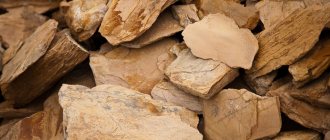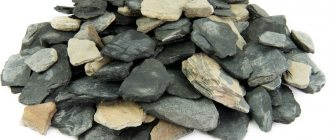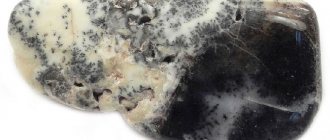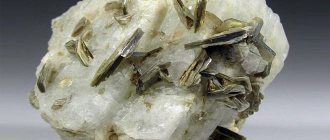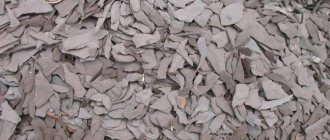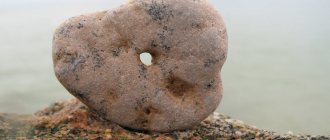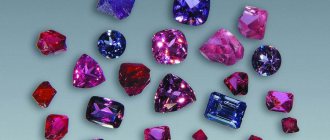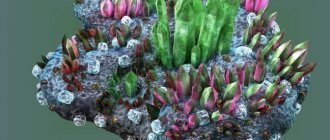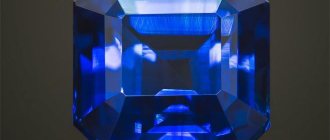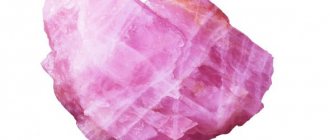Slate rock: description, origin, properties
Slate rock photo
Slate is a rock that is several hundred million years old.
The formation of this mineral occurred either in the bowels of the earth as a result of active volcanic processes, or deep under water, when silt and clay formations that sank to the bottom were compressed under high pressure.
Natural slate consists of plates, the structure of which contains quartz inclusions and feldspar particles. Mica schists are distinguished by the presence of mica in their composition.
Depending on what underlies it, rocks can exhibit different physical properties.
For example, different samples may show completely different levels of hardness. Some of them score 2 on the Mohs scale, while others score 6.
The natural mineral also has different thermal conductivities. So, there are rocks that burn well, and there are absolutely fireproof ones.
The same applies to indicators such as water resistance and resistance to various external influences.
Shale deposits are distributed throughout the world. Particularly large deposits have been found in North and South America, in some countries of Europe and Central Asia. On the territory of the Russian Federation, production is mainly carried out in the Siberian region, the Urals and the North Caucasus.
Advantages of slate and its scope
The term “slate” hides a unique material of natural origin with a layered structure, which consists of various sedimentary rocks, clay impurities and, in rare cases, quartz. Some types of this fine-grained stone, the formation of which took place in the depths of the sea, contain an impressive part of the fossil remains.
Today, “Tree Bark” slate is in great demand among consumers, which received such a curious name due to its characteristic patterns in the form of streak-like elements of a dark brown hue, alternating with shimmering stripes. Expressive layering, increased strength, a solid choice of shades of the palette (yellow-orange, purple-violet, gray-green, ash-anthracite, etc.) - these and other excellent characteristics could not help but make the mentioned stone one of the most popular and sought-after in construction conditions.
The standard thickness of “Tree Bark” slate is recognized to be 15-30 mm. It can be safely classified as a luxury material, since it is the true embodiment of impeccable decorative properties coupled with an iridescent surface. The naturally chipped outer surface of such slate looks very luxurious, while it does not lose the richness and brightness of its original color throughout its entire service life.
Advantages of “Tree Bark” slate
It makes sense to add the following to the other advantages of this stone:
- excellent fire resistance characteristics;
- compressive strength (in a water-saturated state) – 177 MPa;
- compressive strength (in air-dry state) – 272 MPa;
- good brand for frost resistance (withstands up to 50 defrost-freeze cycles);
- low level of water absorption - only 0.45%;
- does not create a favorable environment for the growth of bacteria, fungus and mold;
- relatively light weight – 45-50 kg/m2;
- environmental harmlessness – absence of toxic substances in the composition;
- non-susceptibility to cracking under the negative influence of chemical nature, etc.
Where is Tree Bark slate used?
This natural material with a texture that imitates the bark of natural wood is indispensable in the production of various compositions for landscape design. So, many structures are created from it - this is the so-called rocky garden, which is a small hill on which mountain plants and alpine flowers (rock garden) are planted in a certain order, and artificial rocks on a summer cottage, and retaining walls.
In addition, practical slate with an unforgettable wood pattern is very popular in the manufacture of bricks for finishing walls, partitions, basement structures, as well as in the development of slabs for covering garden plots and sidewalk paths.
Variety of slate types
According to the main classification, shales are divided into clayey and crystalline.
Clay rocks are most often dark gray or green in color. The compressed clay contains inclusions of quartz, sulfur pyrite, lime spar, mica, rutile and many other minerals.
There are separate groups that are formed according to criteria such as structure, composition and physical properties:
- Gray roofing and black slate (or black mountain slate). They are easily separated into plates and are widely used in various technical fields.
- Slate slate is quite soft and is divided into oblong columns. The color of the slate slates is grey.
- The greenish grinding variety is distinguished by its high hardness and high silica content.
- The soft black drawing mineral contains a lot of carbonaceous matter. And the alum variety is also rich in sulfur pyrites.
Crystalline schists have a denser structure and, due to the presence of dark-colored minerals, have a corresponding color.
Sometimes inclusions of quartz or feldspar are found in the composition, which explains the presence of light stripes. Sometimes completely white slate is also found.
Oil shale
Oil shale (OS) - pyrobituminous shale - sedimentary rocks of carbonate-clayey (marly), clayey or siliceous composition, containing 10-50%, rarely up to 60%, syngenetic sedimentation of organic matter kerogen.
GS have a brown, brown-yellow, gray, olive-gray color, leafy or massive texture.
Shale formations are rocks consisting of clayey limestones and silica, which are saturated with organic matter (OM). These are the main oil source rocks in almost all oil and gas basins of the world.
The term "Oil shale" is sometimes used to designate all high-ash solid caustobioliths containing organic substances of various origins and various transformation conditions (carbonaceous, bituminous and liptobiolite shales). Kerogen-syngenetic organic substance with sedimentation with a high yield of resins during dry distillation, with a limited yield of bitumen, extracted with organic solvents at low temperatures. It is rich in hydrogen and its content is closer to oil than to coal.
Geologically, kerogen is proto-oil; its content in oil shale ranges from 10% to 60-80%.
The starting material for the organic matter of oil shale was the biomass of predominantly lower algae (sapropelic components), to a lesser extent higher plants (humus components) and partly animal organisms. According to the ratio of sapropel and humus components, HSs are divided into: sapropelites (HSs of the Baltic shale basin, Volga basin and Boltysh deposit),
saprohumites (menilite schists of the Carpathians).
A distinctive genetic feature of the organic matter of most hydrocarbons is its accumulation in bottom sediments under normal oxygen conditions.
The organic matter of HS is characterized by a high hydrogen content (7-10%), a high yield of volatiles during thermal processing (up to 90%), and a high specific heat of combustion (Qbdaf = 29-37 MJ/kg).
The main mineral components of the GS are calcite, quartz and clay minerals; feldspars, pyrite, and accessory minerals are of subordinate importance.
Application of slate stone
Slate building stone
Natural slate has long been actively used as a finishing material in the construction of buildings, in landscape design, and for the interior decoration of houses. For example, siltstone shale, the development of which began in the 19th century, was used in the construction of St. Isaac's Cathedral in St. Petersburg. Siltstone plates have a unique color (beige-burgundy, sometimes pink) and an interesting texture.
Crystalline varieties of the rock perform well as a building material. They withstand low temperatures and withstand exposure to ultraviolet rays. This material is very strong and will last a very long time. In addition, it has high sound insulation and excellent heat retention in the room.
Oil shale is used not only as fuel, but also as a raw material for the chemical industry. It is distinguished by its low density and a variety of color options (from gray-yellow to black). However, the active use of this material is hampered by a rather expensive extraction process, attempts to improve which do not stop.
slates
Details Category:
ASPID SHALES
, a fine-grained shale rock. They come from clayey sedimentary rocks containing quartz, silicates, mica and carbonates of calcium, magnesium and iron. Slates are distinguished by their elasticity and strength, although their hardness is not very significant. The mineralogical and chemical composition of slate shales can be quite different. The approximate mineralogical composition of slate schists is: mica (sericite) 38-40%, chlorite 5-18%, quartz 31-45%, hematite 3-6%, rutile 1-1.5%. The color of slates is gray, bluish-gray, black, yellowish, and sometimes red or purple. The black color is due to hydrocarbon substances, other colors are due to iron compounds, yellowish-brown and brown are associated with weathering. Industrial slates are: 1) slate, or slate itself, also called roofing, 2) construction, slate. It is impossible to draw an exact boundary between the two.
Properties of slate and actual slate slates. Specific gravity 2.7-2.9. Melting point is about 1300°. Tensile strength 257 kg/cm2. Compressive strength 721 kg/cm2. Dielectric constant 6-7. Electrical resistivity is about 1855 x 103 Ohm∙cm for newly mined rock; as it ages, it grows, and after 3 months it can be considered on average equal to 4700 x 103 Ohm∙cm. However, only dry slate free from veins and inclusions have such resistance. Breakdown electric strength from 1960 to 3920 V/cm (max). Slates are non-combustible, fire-resistant, easily split into smooth plates 3-6 mm thick, can be polished well and can be impregnated with waterproof compounds. The above properties characterize good quality slates. Defects and shortcomings of slate slates: imperfect or not completely flat cleavage with conchoidal dents; colored stripes; color change over time; the inclusion of pyrite, chlorite, quartz, etc. - to a certain extent, and carbonates, magnetite and graphite - unconditionally; fracturing.
Deposits of special slate shale of the highest quality, such as electrical slate, are very valuable and are not found often. Proper development of deposits is so difficult that even under good mining conditions, no more than 25% of the material suitable for further processing is obtained from the quarry. Slates come from the quarry in slabs 150 mm thick or more. Each slab is tested at the mining site for the absence of electrically conductive conductors with a voltage of 2200 V; The current through the plate should not exceed 20 mA.
Applications of slate slates. One of the most critical uses of slate is in the electrical industry; in America they are the most commonly used material for distribution boards. Slabs of slate are sawed and split on special machines, then either polished with sand and water, or polished with carborundum. In electrical engineering, slates are also used for switches, as cutting boards - laboratory, medical, industrial - in the battery industry and for billiards; Slates are widely used for sharpening stones, for slate boards and for slates, the latter being used with slate with intersecting cleavage systems. Broken slate is sprinkled on the soil of vineyards to better absorb solar heat; in crushed form (passing through a sieve with 10-30 holes in a linear inch), slate is mixed with asphalt for making roofing felt, for making fire-resistant putty, etc.; finely ground slate produces a “slate” paint. Slates have one significant drawback - water absorption. This disadvantage depends on the presence of clay. Its significant content is recognized by its smell or by the capillary rise of water - a few cm in 10 minutes, whereas in dense micaceous slate this occurs no earlier than after 24 hours. When it is necessary to unconditionally eliminate the absorption of water, slate is impregnated with the appropriate composition.
Extraction and consumption. The consumption of slate as an electrical material and as a grindstone is rapidly increasing; As for the use of slate for roofs, for slates and slates, it is relatively insignificant due to the competition of more advantageous materials (asbestos plywood and tiles for roofs, artificial masses and aluminum for slates). The largest amount of roofing slate is mined in the USA.
The amount of slate mined is sometimes measured not by its mass, but by the area of the resulting plates; per 1 ton there is approximately 31 m2 of roofing slate area. The demand for slate slate in Russia was satisfied by Ch. arr. import; its dimensions are insignificant and reached 1614 tons in 1913, costing 187,600 rubles. A relatively small part of the Russian market's needs was satisfied by domestic slate production. The local price of roofing slate in the USA in 1924 was about $325 per 1 ton, or $10.8 per 1 m2. The price under the same conditions for construction slate is $0.42 per 1 m2.
Slate deposits within the USSR are known in the southern Urals, Altai, Caucasus and Krivoy Rog. All are of industrial value and can produce good or satisfactory slate.
Source: Martens. Technical encyclopedia. Volume 1 - 1927
- < Back
- Forward >
The healing properties of slate
In addition to its qualities, which are used in various fields of industry and construction, slate also has some healing properties.
It has long been noticed that if you are in a room decorated with this material, your nervous system calms down, your well-being improves, and stress is relieved.
If you heat a piece of such a stone and apply it to a sore spot, the unpleasant symptoms will go away. In addition, it is useful to drink water infused with it.
Chemical composition of shungite used as a sorbent
| № | Element, Component | Component formula | Content % by weight |
| 1 | Aluminium oxide | Al2O3 | 4,05 |
| 2 | Iron(III) oxide | Fe2O3 | 1,01 |
| 3 | Iron(II) oxide | FeO | 0,32 |
| 4 | Potassium oxide | K2O | 1,23 |
| 5 | Calcium oxide | CaO | 0,12 |
| 6 | Silicon oxide | SiO2 | 36,46 |
| 7 | Magnesium oxide | MgO | 0,56 |
| 8 | Manganese oxide | MnO | 0,12 |
| 9 | Sodium oxide | Na2O | 0,36 |
| 10 | Titanium oxide | TiO2 | 0,24 |
| 11 | Phosphorus oxide | P2O3 | 0,03 |
| 12 | Barium | Ba | 0,32 |
| 13 | Bor | B | 0,004 |
| 14 | Vanadium | V | 0,015 |
| 15 | Cobalt | Co | 0,00014 |
| 16 | Copper | Cu | 0,0037 |
| 17 | Molybdenum | Mo | 0,0031 |
| 18 | Arsenic | As | 0,00035 |
| 19 | Nickel | Ni | 0,0085 |
| 20 | Lead | Pb | 0,0225 |
| 21 | Sulfur | S | 0,37 |
| 22 | Strontium | Sr | 0,001 |
| 23 | Carbon | C | 26,26 |
| 24 | Chromium | Cr | 0,0072 |
| 25 | Zinc | Zn | 0,0067 |
| 26 | Water | H2O | 2,18 |
| 27 | Loss on ignition | PPP | 32,78 |
Shungite ash (like all natural coals and bitumens containing impurities) contains vanadium, nickel, molybdenum, copper, etc. Due to the relative ease of obtaining various carbon allotropes, shungite is categorized as a promising material for the development of nanotechnology and is an object of study in nanotechnology institutes [5][6].
